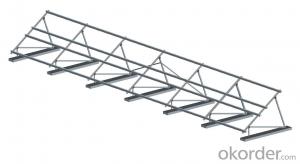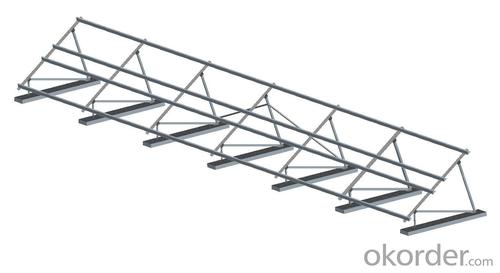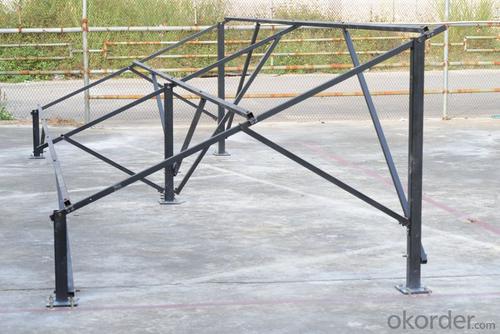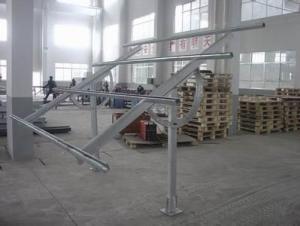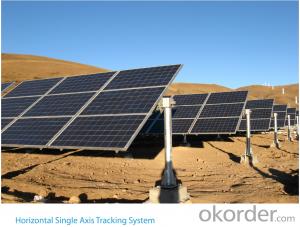Ground Mount Solar Racking Systems - TT-SK-04 Solar Panel Mounting System
- Loading Port:
- Shanghai
- Payment Terms:
- TT OR LC
- Min Order Qty:
- -
- Supply Capability:
- 50万套 set/month
OKorder Service Pledge
OKorder Financial Service
You Might Also Like
PV Mounting brackets are special solar photovoltaic systemfor placing, installing, fixing the solar panel design. Generally materials arealuminum, steel structure, stainless steel. PV mounting products at groundmounting system, flat roof mounting system, adjustable angle roof rack system,inclined roof rack system, column bracket system.
The Ground Mounting System including concret basement sysytemand steel pipe sysytem, Titanergy provides total solution for flat or pitchedroof with patent products.On the basis of the given project data, specificnational standards and guidelines, Titanergy will calculate the completestructural analysis and create a complete project plan to make sure reliablestructural safety.We provide high quality HDG steel and aluminum products forthe ground mounting sysytem,witch can make sure the security and durability ofthe project.
Features and Advantages
n The rail bracket is easy to install, just use simple tools(eg, Allen wrench) can be easily installed. Rail connecting member can freelyadjust the length, the stent may be pre-installed on the roof, and thenappropriately adjusted according to the size of the solar panel.
n The combination of strong, aluminum rails and card blocks fora variety of venues and a variety of materials roofs (such as metal, ceramicand other kinds of tile surface)
n Component compatibility, and rail can meet PV modules fromdifferent manufacturers.
n accuracy, the length of the rail to the nearest millimeter,the construction process, not because of the length is too long or too shortfor the second cut.
n flexible assembly, rail hooks can adjust the spacing modulearray and tile has been installed successfully address the uneven roofconstruction led to difficult problems.
n design standards, product design and development process instrict accordance with GB, the German standards and other internationalstandards to ensure products reach the world advanced level.
n Quality assurance, the stent main material is high-qualityaluminum and stainless steel, effectively prevent corrosion of oxidation.Products can be recycled, reducing environmental pollution.
n Carried out strictly according to the current specificnational standards
n Perfectly optimized components and complete structuralanalysis for the sysytem
n High corrosion resisitance ensure the stability and highdurability
n Total test and certification make sure the high quality ofthe products
n Maximum pre-assembled in factory,quick mounting onsite,timesaving
10-year durability warranty
Technical Data
n Design Period:25 years
n Installation Site: Open area
n Array Angle:10°~60°
n ModuleType:Framed or unframed
n Material:Q235B,Al 6063-T5,Al 6005-T5,StainlessSteel A2-70
n Coating:HDG/Anodised



- Q: Can a solar mounting system be used with different panel orientations?
- Yes, a solar mounting system can be used with different panel orientations. The flexible design of many solar mounting systems allows for easy adjustment and installation of solar panels in various orientations, such as portrait or landscape. This adaptability enables optimal positioning of panels to maximize sunlight exposure and energy generation regardless of the panel orientation.
- Q: Can a solar mounting system be used in areas with limited access to solar podcasts?
- Yes, a solar mounting system can be used in areas with limited access to solar podcasts. Solar mounting systems are designed to support and secure solar panels in place, ensuring optimal exposure to sunlight for maximum energy generation. While solar podcasts may provide valuable information on solar technology and maintenance, they are not essential for the installation or functioning of a solar mounting system. The system's effectiveness primarily relies on proper installation and positioning of the solar panels to capture sunlight effectively.
- Q: Are there any specific requirements for installing a solar mounting system on the ground?
- Yes, there are specific requirements for installing a solar mounting system on the ground. Some of the key requirements include a suitable location with sufficient space and unobstructed access to sunlight, a stable and level ground surface, proper soil conditions for anchoring the mounting system, compliance with local building codes and regulations, and consideration of any potential shading issues. Additionally, factors like wind speed, snow load, and seismic activity may also influence the design and installation of the mounting system.
- Q: Can a solar mounting system be used in areas with limited access to skilled labor?
- Yes, a solar mounting system can be used in areas with limited access to skilled labor. Many solar mounting systems are designed to be easy to install and require minimal expertise. These systems often come with detailed installation manuals and can be assembled using basic tools. Additionally, some solar companies offer installation training programs to educate local laborers in areas with limited skilled labor, enabling them to successfully install solar mounting systems.
- Q: Are there any fire safety considerations for solar mounting systems?
- Yes, there are fire safety considerations for solar mounting systems. As solar panels generate electricity, there is a potential fire risk if proper precautions are not taken. Fire-resistant materials, proper grounding, and adequate spacing for ventilation are important factors in mitigating fire hazards. Additionally, fire safety codes and regulations should be followed during the installation and maintenance of solar mounting systems to ensure safe and reliable operation.
- Q: Can a solar mounting system be used in areas with solar incentives for data centers?
- Yes, a solar mounting system can definitely be used in areas with solar incentives for data centers. In fact, it is highly recommended as it allows data centers to harness renewable solar energy and take advantage of the incentives offered by the local government or utility companies. Installing a solar mounting system can help data centers reduce their reliance on fossil fuels, lower their carbon footprint, and potentially save on energy costs while benefiting from the available incentives.
- Q: Can a solar mounting system be used on asphalt shingle roofs?
- Yes, a solar mounting system can be used on asphalt shingle roofs. There are specific types of solar mounting systems designed for asphalt shingle roofs, which use flashing and waterproofing techniques to secure the system without damaging the roof.
- Q: Can a solar mounting system be installed on a parking lot or garage?
- Yes, a solar mounting system can be installed on a parking lot or garage. In fact, it is a popular option to utilize these spaces for solar panel installation, as it maximizes the use of available space and provides shade for parked vehicles. Additionally, solar installations on parking lots or garages can help generate clean energy, reduce electricity costs, and contribute to sustainability efforts.
- Q: Can solar mounting systems be installed on buildings with limited foundation options?
- Yes, solar mounting systems can be installed on buildings with limited foundation options. There are various mounting options available, such as ballasted systems or roof attachments, which can be used to install solar panels on buildings without the need for a traditional foundation. These alternative mounting methods provide flexibility and can be customized to suit the specific requirements of buildings with limited foundation options.
- Q: Can a solar mounting system be used on thatch roofs?
- Yes, a solar mounting system can be used on thatch roofs. However, it requires careful planning and installation to ensure the stability and integrity of the thatched roof. Specialized mounting brackets and techniques may be necessary to avoid damaging the thatch and to provide proper support for the solar panels. It is important to consult with professionals experienced in both solar installations and thatch roofs to ensure a safe and effective integration.
Send your message to us
Ground Mount Solar Racking Systems - TT-SK-04 Solar Panel Mounting System
- Loading Port:
- Shanghai
- Payment Terms:
- TT OR LC
- Min Order Qty:
- -
- Supply Capability:
- 50万套 set/month
OKorder Service Pledge
OKorder Financial Service
Similar products
Hot products
Hot Searches
Related keywords
